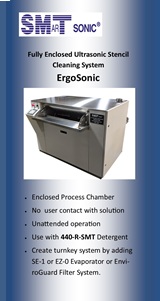|

|
|
| Ask the Experts | |||||||
|
|||||||
|
September 5, 2006 - Updated July 5, 2007 - Originally Posted Help debugging wetting problemsWhat is the best procedure to debug solder problems? We are having wetting problems with gold pads. First board worked fine the next board had major wetting problems across the board. Joseph Otterstrom |
|||||||
| Expert Panel Responses | |||||||
|
There are four things to look at: (1) Component (2) Solder Paste (3) Profile and (4) Board Finish. Since it sounds like there are wetting issues across different components we can discount the components as a cause. Since it sounds like the solder paste worked on one board and not the other, as long as they are the same batch we can discount this as well. Also, if the paste wets to the lead and not the board - then the paste itself is usually not "bad". Profile can also affect wetting. The reason we reflow boards at some temperature above the melt point is because wetting takes energy - supplied in the form of heat in this case. Wetting to nickel (the layer under the gold) is a bit harder than wetting to copper and is therefore the proper profile is necessary. Verify the profile is correct. Finally, the board itself. Of course, the substrate is a critical component to the wetting. In this case we have a thin gold layer over nickel (assuming this is an ENIG surface). During soldering the gold dissolves into the solder and the solder wets to the underlying nickel. One thing that can inhibit this wetting is an organic layer/contamination on the surface. This can be detected either visually, as a film or discoloration on the surface, or using advanced techniques such as Fourier-Transform Infrared (FTIR) spectroscopy. This can also appear as a black or brown discoloration around the solder joint itself. With surface finishes the metalization itself can become oxidized. Since the top layer here is gold, and gold is noble metal, this is unlikely. What could be oxidizing is nickel. The nickel can "get to" the surface if the gold is porous or it is too thin. Nickel oxidizes very quickly and oxidized nickel is unsolderable. This can be seen by analysis using cross sections or top-down SEM/EDS or possibly visual inspection under a microscope if it is gross nickel migration. Finally the nickel layer itself under the gold can be compromised. In this case the gold dissolves into the solder and the solder can not wet the underlaying nickel. The best way to try and determine if this is a problem is to do a cross-section and look at the Ni-Au interface.
Application Engineering Henkel Electronics Dr. Brian Toleno is the Application Engineering Team leader for Henkel Technologies. He is responsible for the technical service and application engineering for Henkel's electronics assembly materials, including solder paste, underfills, PCB protection materials, and underfills.
Wetting issues are driven by board, solder, component interactions. Your letter seems to suggest solderability issues across the board, so we can effectively rule out a particular component. Assuming that you have confidence in your soldering profile, then the focus will be on the board. For ENIG boards (I am assuming that is your 'gold' pads), first take a good look at the pad. Any staining or discoloration? Perform FTIR. If there are no obvious surface discolorations, consider XRF to ensure sufficient thickness of the gold and the nickel underplate. If the thicknesses look nominal, consider SERA or ion chromatography (IC). SERA will report the presence of any oxides or intermetallics that could be interfering with the soldering process. IC will provide information on overall cleanliness of the board, which always plays a major role in solderability.
CEO & Managing Partner DfR Solutions Dr. Hillman's specialties include best practices in Design for Reliability, strategies for transitioning to Pb-free, supplier qualification, passive component technology and printed board failure mechanisms.
|
|||||||
| Submit A Comment | |||||||
|
Comments are reviewed prior to posting. You must include your full name to have your comments posted. We will not post your email address. |
|
Free Newsletter Subscription
Circuitnet is built for professionals who bear the responsibility of looking ahead, imagining the future, and preparing for it. Insert Your Email Address |
|

|




